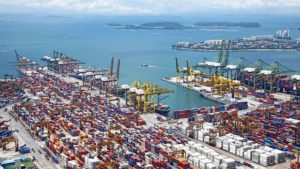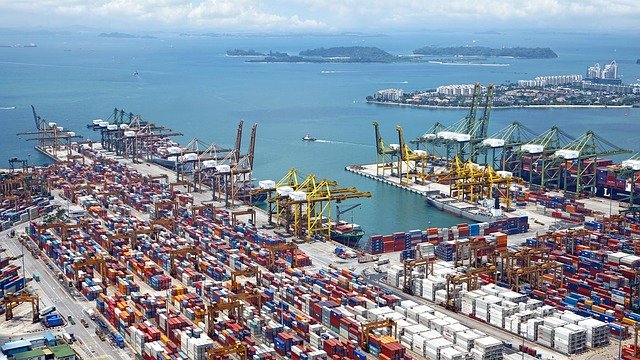 Philippine port authorities and cargo transport service providers are anticipating a slowdown in ship calls, reduction in cargo volumes and higher costs as a result of the global outbreak of the novel coronavirus disease (2019-nCoV).
Philippine port authorities and cargo transport service providers are anticipating a slowdown in ship calls, reduction in cargo volumes and higher costs as a result of the global outbreak of the novel coronavirus disease (2019-nCoV).
Shipments of semiconductors and perishables are likely to be affected the most since many are transported by air, according to multimodal transport operators. A number of airlines have already either cancelled or significantly reduced their flights to China since the virus outbreak.
Following the expected slowdown in shipcalls, yard utilization at offdock depots is also seen to increase as empty containers may not be shipped out based on the usual schedules.
To stop the spread of the virus and in response to tepid global demand, international shipping lines are already cutting the number of seaborne vessels, threatening to disrupt global supply chains.
According to the United Nations Conference on Trade and Development, about 80% of world goods trade by volume is carried by sea. China is home to seven of the world’s 10 busiest container ports.
Wuhan, the capital of China’s Hubei province, is ground zero of 2019-nCoV. As of February 8, 2019-nCoV has caused more than 700 deaths and infected more than 34,500 in several countries.
“Dahil sa nangyaring ito, inaasahan natin na baka magkaroon ng slowdown ng mga produkto galing sa China dahil nga sila din ay preoccupied o iniintindi nila yung sarili nilang problema sa pagharap ng CoV virus (We expect a slowdown in goods coming in from China as China will be preoccupied with fighting the virus),” Philippine Ports Authority (PPA) general manager Atty. Jay Daniel Santiago in a press conference on February 5.
READ: Ships from China still welcome in PH, says PPA
Santiago said around 83% of cargoes arriving in the Philippines come from China, Hong Kong, and Taiwan, while cargoes from Europe, the Middle East, and the United States also pass through ports in Greater China.
China is the Philippines’ top source of imports, accounting for 22.9% of the Philippines’ total import bill in November 2019, based on data from the Philippine Statistics Authority.
Effect on Cebu port
Cebu Port Authority (CPA) general manager Leonilo Miole, in text messages to PortCalls, said they also expect fewer ship calls “in the short term given that shipping has been the object of health protocols to arrest the coronavirus contagion.” The Department of Health (DOH) and Bureau of Quarantine, as well as some local government units, are implementing measures at seaports to prevent the spread of 2019-nCoV.
“However, we cannot at the moment give a figure or percentage of the extent of reduction. We may have an idea by the end of the month,” Miole said.
He noted though that according to some liners, “items ranging from consumer goods (some perishables), raw materials (for PEZA [Philippine Economic Zone Authority], etc.) and construction materials are common cargoes stuffed inside containers coming from China.”
Miole noted that as of February 6, “it is still business as usual” at Cebu port. Since Cebu is often the second or third port of call for vessels coming from China, he said boarding protocols are “not that stringent anymore since most vessels have Manila as a prior port of call” where they have already been checked.
“Vessel crew are, however, not allowed to disembark nor are people allowed to embark from/to these vessels,” Miole noted.
Vulnerable supply chain
Atty. Maximino Cruz, general manager of the Association of International Shipping Lines (AISL), in an email to PortCalls said: “A slowdown is expected as a big number of ship calls and/or cargo traffic comes from China.”
“The several lockdowns in China to arrest the spread of the virus will necessarily take its toll on the volume of cargo traffic in the areas gravely affected,” Cruz added.
He explained that because of the expected slowdown of vessel calls, movement of cargoes in and out of the country will also be affected.
“Ship-out of empty containers will not be spared, thus, causing yard utilization at the offdock depots to soar,” Cruz added. He noted that regularity of vessel calls will minimize effects on empty container yards, but “everything hinges on whether the spread of the virus can be immediately contained or not.”
“Let us not forget that empty container yards [are] just but one component of the supply chain. The whole supply chain is vulnerable and can easily teeter [amid] any disruptive event, be it natural or man-made,” Cruz pointed out.
Cruz said shipping lines have already advised their clients on possible delays as the outbreak has been declared an international health emergency.
According to a recent analysis of logistics and supply chain research and consultancy service provider Transport Intelligence, the shipping industry is biding its time before making wholesale revision to services. The Chinese New Year has already led to reduced capacities, and lines are adopting a “wait and see” attitude before blanking additional sailings.
Flight cancellations hurting air cargo
Philippine Multimodal Transport and Logistics Association, Inc. (PMTLAI) president Marilyn Alberto, in a chance interview with PortCalls on February 7, also believes the outbreak will definitely slow influx of cargoes, something that’s already being felt in air shipments.
She noted that the cancellations of flights by multiple airlines, as well as the stoppage in manufacturing in affected areas in China, are already affecting air shipments. Taking the greatest hit, Alberto noted, are semiconductors and perishable goods, which are shipped by air.
Electronic products account for nearly 60% of Philippine exports, led by semiconductors and gadget components, according to the Philippine Statistics Authority.
PMTLAI director Doris Torres, also during the same interview, noted that all these effects also entail additional costs, especially as some companies are forced to ship through air, which is costlier, as they cannot get bookings for sea vessels.
Another scenario is airfreight rates going up once airlines resume flights from China, as companies might all try to immediately ship their products.
For sea shipments, Alberto noted that the effects may not be felt yet as vessels have longer transit times and those arriving in the Philippines might have left China before the outbreak.
On another note, Alberto said the outbreak may an eye opener for businesses to be less dependent on only one country for their production or sources of materials to avoid being hit hard whenever sudden issues erupt. For example, some automakers in South Korea have halted production due to lack of parts from China.
Torres, meanwhile, said the outbreak will test the Philippines’ dependency on imports, especially food products.
‘Too early to tell’
Finance Secretary Carlos Dominguez III said “it’s a little too early to tell” what the effect of the coronavirus outbreak might be on revenue generation and the economy,
During a media briefing on February 7, he said: “The estimates I’ve seen is that if it (situation) really turns out bad, we will probably see a hit of about 3/10ths of 1% of our GDP growth rate…But again we have a very resilient economy.”
Some areas, he noted though, would be affected such as airlines, the tourism industry, and manufacturing, “especially those manufacturers who export to the Wuhan area.”
“We might have less imports from the Wuhan area so that might affect our revenues,” the finance chief noted.
Customs Commissioner Rey Leonardo Guerrero, during the same briefing, said he has received reports from some importers “that they could not ship their exports from China.”
Dominguez, however, stated: “China is a big country. Most of the affected people are in the province where Wuhan is. I don’t think people from Guangzhou are going to be too much affected, or people from Shanghai. But again we don’t really know.” – Roumina Pablo





